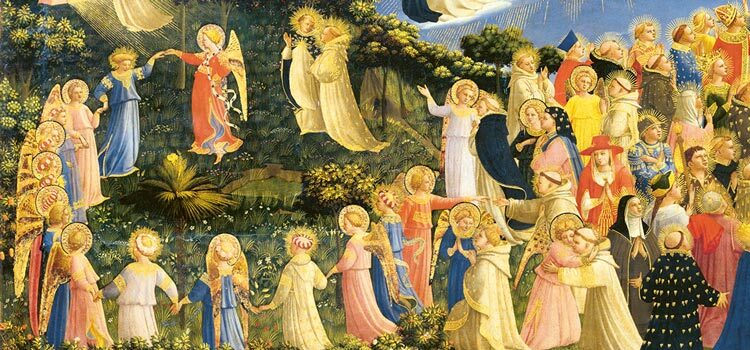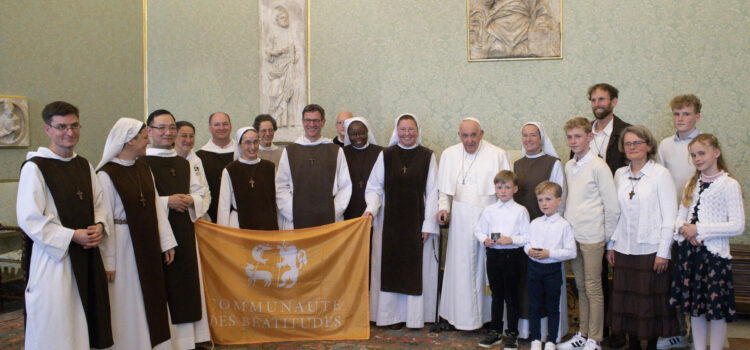In the November bulletin, we have reflected on orison, or quiet personal prayer, as our primary grace. If we live this primary grace as we learn from the Carmelite tradition, it means also that this specific feature of the spring (source) will saturate all it overflows on ; brotherly life and apostolic life. Following this logic, let us look at what orison, learnt from the Carmelite tradition, means and then we shall see what it brings to the other pillars of our life in the Beatitudes.
Watering our garden
The great masters on the subject of Carmelite orison, St John of the Cross, St Thérèse of Avila, have resorted to pictures to describe the path to orison (or silent personal prayer) – climbing up Mount Carmel, the inner castle. We are going to use here another symbol Thérèse of Avila has used. She describes a life of orison as the garden we have to water (cf.Life XI,ss). This garden is our soul. The gardener is God. He clears off the brushwood and sows beautiful plants. Then He entrusts it to our care. Our task is not to plant or to uproot, but to water. The plants represent the virtues. The water represents the graces received through prayer.
Thérèse shows four ways to water this garden, connected to different stages in our life of orison.
The Master of creation hands over his work to us, with much love and trust, and calls us to collaborate with him : a relation made of friendship and trust where the first initiative is the Master’s, but, without the disciple’s answer, the work will not be able to unfold completely. The water is always given, although through different ways, but it is neither used for itself, nor for the gardener’s delight, but for the plants. The graces of prayer are useful to make our ability to love grow in us. (cf. Thomas Green, in « Opening to God »).
Therefore, let us look briefly into these four ways of watering.
1.The well
Using a bucket «we draw some water from the well by sheer strength» ( Life, XIV). It is slow, tiring, and not very effective, a lot of work for little water. But this allows our plants to grow. In orison, it is connected with mental orison: pondering over our life, our daily experiences, with the light of the Gospel, discursive meditation over Christ’s life. Above all, it is our understanding that is diligently at work. At this stage, our difficulty is to keep silent, to focus on a subject. An honest consideration on ourselves, unflattering awareness, do not make it any easier. We have all experienced it, we have a great desire of silence and introversion but as soon as there is an opportunity to enter into it, we draw back. The only thing that can help us is an untiring faithfulness, a firm resolution not to turn back.
2. The bucket-elevator
Without any change on our part, and to our great surprise, the same methods and topics in prayer give us access to the water much more quickly. Thérèse uses the picture of a bucket-elevator (noria) a mechanical help that draws water from the well in a much easier way. All of a sudden, the Lord multiplies the result of our efforts. Everything comes to life, everything starts speaking to us about his love. Till then we have labored to know the Lord and to know ourselves. Now this knowledge opens up for us the joy of meeting Him. Thérèse calls this orison of quietness. We still go to the well but as soon as we reach it, the water starts flowing as if the well was full to the brim, or as the Shabbat cup overflows…
3. The river
There is nothing else to do but to guide the water towards the plants. At this stage one speaks of supernatural graces. Prayer is always a gift. But in the two first stages, our active participation is more important. Experiencing the prayer of quietness sets us in an inner disposition so we can receive what only God can give us: the graces of passive prayer.
4. The rain
It is the most effective way to water our garden. It is the soft but plentiful rain of the springtime. We do not have anything more to do but sit and receive the grace, allow it to penetrate us. In these two last stages we simply hand over to God our time and ourselves in order to let Him do what He wants. We are the clay in the hands of the potter. It may seem easy but is the most difficult thing for us to achieve, we have to surrender completely, to let go of any supervision «to stop swimming but to rest on our back and float, and allow the water to carry us where it wants». (Thomas Green in When the well runs dry).
There is still another phenomenon to be mentioned : Dryness … this happens at all stages. But once we have checked that the dryness is not due to our lazyness or unfaithfulness, we can embrace it like another way to be united with Christ. We seem to need to walk through times of testing so we may learn to truly love. It is amazing to see our garden not getting any drier so far…
An art of life
How shall we put all that into practice in our brotherly life, in our apostolic life? This is worth reflecting on… but maybe we could start with the following points (not exhaustively) : – everything starts with a loving relationship between the Creator and his creature; – our personal responsibility is decisive; – it is a dynamic process under the leading of the Holy Spirit; – in silence and inner watchfulness, we shall recognize the moves of the Holy Spirit; – our adjustment with trust and abandon will lead us to fecundity; – the aim is union with the Beloved;
– this union overflows into union with all created things. The Carmelite tradition makes us enter into a style of life. Our lives get centered, little by little, on God and thus, our relastionship – with Him, with ourselves, with our neighbors, with the world –becomes the heart of our life. As a life of orison shapes us in all these relationships, we collaborate with the work of the gardener. We are the branch that abides in Christ who is the vine. The fruits are his business. The branch has only one thing to do: to focus its sight, its attention on the vine and draw the sap. All the rest is given. Thus, we have a lot to receive from the Carmelite tradition… that is why we shall pursue this topic next month.
THE QUOTATION
«We must cultivate attitudes which are connected with the love that has touched our heart. We will not reach our goal through good resolutions but through our firm pledge to our daily date with God, where we have no other goal but to keep our heart open to this transforming love.» James Finley
To Go Further…Small spiritual practice I consider my life since i do orison and i note the most important steps. Do I recognize one or the other of the steps Thérèse describes? How did the Spirit of God guide me? What does He say to me today? Books
|






